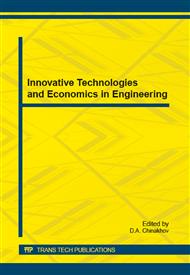p.236
p.240
p.246
p.251
p.256
p.261
p.266
p.270
p.276
Investigation of Composite Deflocculant Influence on the Properties of the Refractory Castable with Chamotte Aggregate
Abstract:
The influence of different types of deflocculants, PCE and sodium tripolyphosphate, on the rheological properties of the cement matrix was studied. It was established that composite deflocculant consisting of sodium tripolyphosphate and PCE Castament FS 20 provides the best rheological properties of the cement matrix and affects the composition of the hydration products. During the drying process of matrix with composite deflocculants mineral stratlingite additionally formed, which contributes to increment of strength properties. Comparative studies of refractory castable strength properties with chamotte aggregate showed that the compressive strength of concrete samples with composite deflocculants after hardening and after drying and burning is almost two times higher than the strength of samples with separate deflocculants.
Info:
Periodical:
Pages:
256-260
Citation:
Online since:
October 2014
Authors:
Keywords:
Price:
Сopyright:
© 2014 Trans Tech Publications Ltd. All Rights Reserved
Share:
Citation:


